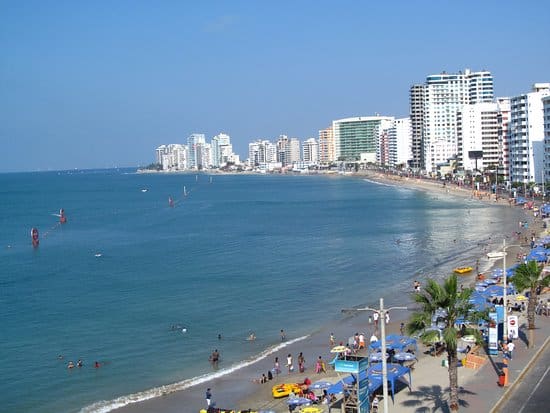Ecuador Infrastructure – A Current Snapshot
Nothing often speaks a higher volume about the relative progress of a nation, or lack thereof, than the current state of its infrastructure. In fact, some great world powers, such as India, are routinely plagued by a lack of sufficient infrastructure advancement, routinely lagging the infrastructure. Recent evidence suggests that investment inflows into India have slowed dramatically, as the infrastructure bottle neck continues.
Other great nations, which one were ahead of the infrastructure curve, such as the USA, have failed to modernize a once cutting edge infrastructure network. Think about it. When was the last time the USA built a great and extensive highway project? How old are the water and sewer systems underneath many of the USA’s great cities? When was the last time the USA extensively studied and revitalized its public education system? Infrastructure must constantly be nurtured and cared for, like a cultivated garden, lest the “weeds” begin to choke off the progress.
Ecuador is no exception. Its development lifeline is the evolution of its infrastructure. A review of even recent past history suggests a nation in struggle, but fortunately for Ecuador expats, the events of the last 6 years have dramatically turned the infrastructure tide, into a positive and sustainable trend. This report endeavors to provide a brief glimpse of Ecuador’s infrastructure progress.
First, at least a loose definition of “infrastructure” needs to be established. Unfortunately, many times the concept of “infrastructure” is viewed through an all too narrow and limiting prism. Sure, infrastructure is definitely, potable water, sewer, electric and roadways. These are the commonly recognized components of infrastructure development. However, the true scope of infrastructure evolution, when practiced appropriately by national governments, entails so much more. For example, arguably any and all of the following are also a part of a nation’s core infrastructure network: schools, medical facilities, bridges, and police/fire services. Our analysis of Ecuador will briefly look at all these components.
Ecuador was a nation in turmoil, just 14 years ago. A collapsed currency, a banking system in crisis, a real GDP economic decline and an infrastructure system, which lay ignored for 50 years. That is why it is said there is opportunity in crisis. If you go back 14 years, Ecuador was a “blood in the streets” investment only. About 5 years ago, it became a mainstream value play, for the “early bird” savvy crowd. Today, it remains arguably one of the top 3 relatively best investment values in the world.
Much of what rescued Ecuador was a deep socio, political and economic analysis, brought about by the crisis of 1998. The dollarization of the Ecuadorian economy was a much needed brief respite, although one could argue even then, it was a bit like going from the fire to the frying pan. Today, I wouldn’t blame anyone for feeling like we have come full circle, back to the fire, given the levels of USA debt and what this portends for the future of the USA dollar. Still, with the Euro an equal or greater disaster, coupled with the absence of an immediately viable global currency, Ecuador’s U.S. dollar play should be recognized as a masterstroke on the way to economic recovery.
The aforementioned socio, political and economic analysis in Ecuador gave way to a new energy, national will and desired direction. Ecuadorians well understood that there was nothing “magical” about the new U.S. dollar currency. If they went back to the ways of old, they would likely wind up in just another economic crisis in the near future. They, instead, opted for a new direction.
The new direction that Ecuador selected was that heralded by now President Rafael Correa, a USA educated economist, with an MS degree from the University of Illinois. While the entire scope of Correa’s national vision goes way beyond the parameters of this report, his vision included a rapid overhaul of the dormant and decayed infrastructure of Ecuador. An infrastructure which had laid largely neglected for at least 50 years. The Correa Administration embarked on a massive public works campaign, with an extensive infrastructure renovation and creation program, which on a relatively comparable basis, mimicked the “infrastructure boom” seen in the USA at the onset of the Industrial Revolution and, again, in the immediate post-World War II era. The results in Ecuador have been breathtaking, with a newly invigorated infrastructure sector, expansive domestic job creation and an impressive economic expansion. Below, each major infrastructure sector is briefly reviewed, as a snapshot of where Ecuador’s vast progress has taken it, today.
Potable water: Even in the city centers, prior to the Correa Infrastructure Initiative, potable water was found only in 82% of municipalities. While way ahead of traditional “Third World” nations, this was not a viable statistic for a nation that was looking to modernize into standards of the 21st Century. Even worse, the rural municipalities saw numbers significantly below the aforementioned figure, although exact figures are hard to categorize, since government data was sporadic and relied mostly on uneven local data collection and processing. This was all made worse by an utter reliance on federal government funding, with no effort made at recouping the costs at a local level.
Today, since the infrastructure reforms of President Correa, Ecuador’s potable water numbers stand at 96% for urban areas, and an 89% accessibility figure for improved potable water supplies in the rural areas. However, this latter rural figure, while a vast improvement over previous available data, is tempered by a still very respectable 73% figure for true “piped on premises” potable water. The advances, in a short 6 year period of time, have been nothing less than impressive. However, much work remains within Ecuador, regarding potable water. For example, only 8% of all collected wastewater is being actively treated. Also, the levels of “non-revenue potable water” (that produced but “lost” prior to reaching the end user), still stands at a challenging 65%! These items are a priority for the Correa Administration, moving forward, as is a continuation of the trend where local municipality initiatives are funding potable water projects, instead of 100% full reliance on federal government funding. The trend, while still evolving, cannot be currently looked at as anything except having a positive outlook.
Public sewers: Improved sewer sanitation figures have risen from a pre-Correa figure of 77% to a 96% urban sector success, in the post-Correa infrastructure reforms era. Quite a long jump, in a scant 6 year period. Corresponding before and after figures for the rural districts are 53% pre-Correa programs and a current figure of 79% of household now enjoying improved services. This latter rural figure is a particularly amazing improvement, when one considers that Correa inherited a rural sanitation system that as recently as 2004 was deemed to be 38% collapsed, 20% seriously damaged, 29% somewhat damaged and only 13% considered fully sustainable in what had been the current condition. That is what 50 years of infrastructure inertia will do for you.
Experience the Insider community that takes your international lifestyle to the next level. Download your FREE guide
"18 Steps to Implementing Your Plan B" instantly!
If one looks at “piped to premises” full public sewer penetration, one finds that the urban areas enjoy a 72% penetration rate, while the rural areas show a 53% penetration rate. Both figures represent jumps of over 20% from the basis prior to the Correa Administration reforms, even using conservative data. Once again, one sees a positive outlook infrastructure development in Ecuador. Still, much room exists to improve coordination between federal government agencies and the local authorities responsible for enhancing access to public sewer. Clearly, the rural areas still have quite a bit of catching up to do. The positive outlook remains firm, but also evolving. The need for long-term sustainability programs is paramount and a top-priority of the Correa Administration.
Electric service: An immediate conversation starter to any discussion of electric service in Ecuador must begin with the consideration that 42.55% of the installed electrical capacity in Ecuador is directly provided by hydro-electric power. That means that during unusual and infrequent drought periods, the Ecuador power grid can suffer. This exact event occurred in late 2009, lasting for a 3 month period between November 209 and January 2010. It generated a rolling blackout scenario, with some regions going for 2 consecutive hours without power and others for as long as 6 hours.
Still, despite this rare, but recent, shortcoming, 96.09% of the renewable energy capacity in Ecuador is hydro-electric power. The Correa government has launched a bold 2020 plan, to achieve 86% installed capacity for hydro-electric energy, an almost doubling of the existing numbers. The 40-year “freak drought” of 2009, taught the Correa Administration and the country of Ecuador much about water management, the need to maintain a significant back up generation system (since purchased) and to better plan for readily switching to alternative energy sources, during future droughts, as they may occur.
At the end of the day, electric capacity has seen an upswing of over 20%, during the Correa Reforms Era, with penetration to rural areas exceeding those numbers, and central coordination and planning showing vast improvements. While Ecuador remains a net power importer, current projections show a strong upsurge in production through 2020, with electric energy production figures expected to surge between 30%-40%, from current levels. Overall, a positive outlook remains in play, for the future of Ecuador’s electric sector.
Road network: Three words. Ruta del Sol. Literal translation – Route of the Sun. If that had been the Correa administration’s loan accomplishment in road construction, it would still have been deemed a feat of excellence. However, it was just one of many critical road networks developed under the Correa government, in a brief period of time.
The Ruta del Sol (now, by the way, rechristened the Ruta de Spondylus, with the literal translation of “Route of a really ugly crustacean” – never going to hear me call it that) was initiated as a superb highway connecting almost the northernmost tip of Ecuador’s coastal frontier, to literally almost the southernmost tip of Ecuador’s coastal expanse. Instantly, what had been, until then, a limited access coastal wonderland, became a readily accessible tourism “hot spot”, with dozens of beachfront towns springing up across Ecuador, to entertain both domestic and foreign visitors. Ecuador’s exotically beautiful beaches were soon opened up for all to gaze, wander and enjoy, thus making Ecuador the only country in South America with truly gorgeous Pacific Ocean beaches that were also readily accessible via an organized system of roadways. Keep in mind, for all my friends from beautiful Colombia, that the premiere, accessible beaches in Colombia are Caribbean beaches, not Pacific Ocean side beaches.
One could argue that none of Ecuador’s infrastructure sectors was more ignored in the 50 years prior to President Correa than the road network. Mud roads, in the tradition of what can readily still be found in Belize and Costa Rica today, were the order of the day for Ecuador. Many sierra towns did not connect to each other, much less the beautiful Pacific coast. Where semi-paved roads existed, the potholes could swallow a Buick. It was not a pretty sight, let alone much fun to tour. Against this backdrop, the Correa Administration dumped $800 million of road improvements into the economy of Ecuador, literally tripling the previous road construction rate in only his first 3 years in office. Domestic employment, tourism dollars and the construction sector all flourished, as did the rural agrarian sector, which was now able to bring product to market and for international export, with much greater ease and efficiency.
Some have said that the road to Correa’s presidential success is, quite literally, the enviable success of his road construction program. With the outlook in this infrastructure sector nothing but positive, including a 2011 pledge to up the ante and invest a total of $5 billion in new road infrastructure, Ecuador’s economy appears poised to ride a freshly paved the road to success.
Bridge network: President Correa inherited a country with mostly dilapidated or altogether nonexistent bridges. More than 50 years of neglect and inertia had virtually ground major bridge infrastructure construction to a standstill. Entire sections of the country did not have strategic interconnectivity.
Since the Correa Administration, a new urgency has taken root with regard to bridge construction. Just a partial list of bridges overseen by the Correa government, includes:
The Atirantado Bridge in Quevedo;
The Rio Pastaza Bridge in Baños;
The Rio Napo Bridge;
The bridge over the Copueno RIver;
The bridge over the Catamayo River;
The bridge over the Angel River in Carchi;
The Guayallabamba Bridge;
The Rio Chice Bridge;
The Rio Esmeraldas Bridge;
The Cascales Bridge in the Amazonas region;
The Unity Bridge in Ambateña;
The National Unity Bridge in Guayaquil;
The Bridge over the Upano River;
The Rio Chota Bridge;
The bridge connecting Rio Verde and Palestina;
The Segmental Bridge crossing the Babahoyo River in Durán;
The Napo River Bridge in Orellana;
The bridge known as Puente Internacional, connecting Ecuador and Colombia; and
The grandaddy of them all, the Los Caras Bridge, crossing the River Chone and linking Bahia de Caraquez with St. Vincente (the longest bridge in Ecuador).
Currently, plans exist to update additional bridges and to build new ones, under Correa’s previously mentioned massive $5 billion road network program. The sector’s future outlook, for the first time in more than 50 years, looks extremely positive.
Schools & universities: To say that President Correa has undertaken a top-to-bottom overhaul of the public education system, still seems like an understatement. One has to understand the sorry state of the system, when Correa took office. In fact, the examples are so numerous of the systemic failure, it is almost difficult to know just where to begin.
However, perhaps nothing is more telling than to highlight that Ecuador had no formal testing or qualifications system for its national teachers – not at the grade school, high school or university levels. The system was less merit-based than one of “who you might know” at the school administrative level. Since then, the systemic testing of teachers has been implemented, with pay linked directly to test results. More so, for those teachers failing the tests, they have a maximum period of time within which they must receive accreditation, or permanently face the loss of their career position.
In addition to the preceding, President Correa has endowed the education sector with dramatically increased public spending, raising the GDP % from 2.5% in 2006 to 6% of GDP in 2013. The teachers that have met the new stringent testing and qualification requirements have also seen payroll rise by 25%.
Furthermore, students from throughout the country have received medical and nutritional assistance, in addition to the “free lunch” and uniforms program. This attention to student detail has newly endowed Ecuador with the lowest illiteracy rate amongst all Andean region nations.
Correa pressed forward with a successfully ambitious school renovation and construction program, which witnessed the swift renovation or building of 5,000 schools throughout Ecuador, including in many rural towns and villages, which previously had no direct access to a local school.
In Correa’s Ecuador, university students are now receiving a free, merit-based scholarship education, at full government expense, for the world’s top universities, including Harvard, Oxford, Stanford, London School of Economics, and the Sorbonne. Soon, students will have less of a need to seek the highest quality of education, outside of Ecuador, with the creation of a new national high-tech research complex, dubbed Yachay – City of Knowledge (covered in a separate report), under construction just outside of Quito, as well as a new national education university, to be located just north of Cuenca. The latter is designed to provide world-class training to school administrators, policy makers and teachers, from primary school through the university graduate levels. The government has begun to recruit educators from other countries and announced in October 2012, the hiring of more than 100 Ph.D.-level professors from Spain.
Overall, the Correa Administration has reenergized the education sector of Ecuador, with scholastic enrollment now mandatory by age 5 and with a level of gross enrollment, which has seen a 10% jump overall and an over 20% jump at the primary level. To suggest that such a rapid improvement is just shy of miraculous is no hyperbole, as we definitely portend a strong positive future trend for this infrastructure sector.
Medical & Health: In the pre-Correa era severe needs in healthcare plagued Ecuador, including lack of hospitals, doctors that worked when they wanted, poor rural penetration of even basic medical care and absolutely no modernity and upgrading at hospitals and health clinics. The sorry state of affairs was concisely summed up by the World Health Organization (WHO), which retroactively has stated, “The government funds 47% of outpatient and hospital services in the nation, in addition to the nation’s largest hospitals for referrals. But by WHO standards, there should be between 8 and 10 hospital beds available per thousand people. The number of available beds in the Ecuadorian hospital system was only 1.7 per thousand; many hospitals remain at full capacity.”
Against this backdrop, a newly elected President Correa vowed to massively increase the health budget; to dramatically increase the production and distribution of medicine; to create preventive health campaigns; to significantly increase the number of public doctors and nurses; and to implement mobile medical brigades. His goal was to plow a whopping $5.3 billion into health care reform
Signs of progress emerged when the healthcare budget saw a sharp increase from $561 million in 2006 to $1,774 million in 2012, which is now 6.8% of the national budget. The Ecuadorian government also signed an agreement with the Cuban government to allow public company Enfarma to massively produce medicine at low cost. Furthermore, working hours for doctors were increased to 40 hours/week and their salaries were also increased. Mobile hospitals have been rapidly created. An economic incentive program has been introduced to persuade the return of medics amongst Ecuadorian emigrants.
The Ecuadorian government has also personally built 18 hospitals and 250 health centers across the nation, including many health clinics in rural towns and villages, which previously lacked access to basic healthcare, making primary healthcare, especially preventive treatment, more accessible to the poor. The Correa administration has also hired more doctors to support the country’s growing Social Security health care system, which saw a 300% expansion, including the addition of new community facilities, latest high-tech medical equipment and the creation of state-of-the-art regional hospitals. Notably, expats under the age of 60 have the option to buy in to the Social Security insurance program for less than US$70 per month!
Due to such advances, Ecuador has already achieved remarkable progress in healthcare. One area, child mortality rates, can be cited as an example. To adequately analyze this progress, it is important to give context because of the diminishing returns that inevitably come as countries reach lower mortality rates. Ecuador began the period, starting in the year 2000, slightly ahead of its peers: mortality rates were 2 to 3 percent lower in Ecuador than in the overall group. But these gaps have continued to widen, both in absolute and relative terms. By 2010, Ecuador’s infant and child mortality rates had fallen to nine and 12 percent, respectively, below the group average.
Despite the significant advantages ushered in by the Correa Administration, Ecuador still needs decades of increased investment in health care to reach an appropriate level, but plethora of current data on the substantial progress made under Correa, indicates a strongly positive trend for Ecuador’s medical infrastructure.
Police & fire services: Police and fire services had been reasonably advanced in major cities, but rudimentary, at best, elsewhere, during the Pre-Correa period. Police/Fire sub-stations, where they even existed, were dilapidated and not worthy of being occupied. Equipment was old, training near non-existent and morale low. Even worse, both police and fire services – but especially police – were highly susceptible to the politics of local patronage.
Correa took office and immediately declared the modernization, training and specialization of these critical forces, a matter of top-priority. He immediately identified the need to separate the functions of the police into four areas: narcotics, border, transit and public safety, while recognizing the need to enhance fire fighter training, based on the best global service practices. Additionally, partially to address existing morale and partially to attract better skilled and educated cadets, Correa proposed to increase salaries and improve the physical condition of Police/Fire buildings and structures. Finally, Correa pushed for the creation of a public safety ministry, to better coordinate professional activities and secure public safety.
Immediate successes and results could be seen. The Correa administration successfully completed an accelerated restructuring of the National Police. The traffic-focused,Transito Police was born, to ensure traffic safety and cut down on an extremely high traffic accident rate. Local area Fire departments were paired with international “sister-city” Fire departments to ensure proper training of best practices and the newest fire-fighting techniques. For example, quite ironically, my local Salinas Fire Department is paired with the Chicago Fire Department (CFD), which was my home town, when I lived in the USA. So, I routinely get to see and interact with members of the CFD, who train our local fire fighters. Additionally, new trucks and ladder equipment, better suited to address the increasing number of Ecuadorian high-rises were purchased for fire departments throughout Ecuador. In fact, in total, the police and firefighters have received thousands of new official cars, to replace the previously dilapidated fleets.
However, the greatest majors changes probably are three other accomplishments, not even mentioned, yet. First, the Correa Administration has built and/or renovated over 50 police sub-stations and fire stations, each, throughout Ecuador. The communities receive more functional buildings and services and the public servants receive more decent, humane and habitable accommodations. A definite win-win!
Secondly, the Correa government has extensively expanded the mandatory scope and quality of professional training & education, for both Police and Fire forces. This has led to increased professionalism, better response times and a more successful service rate, for each of the specific departments.
Finally, the Correa Administration implemented a zero tolerance policy on bribes or gifting to professional Police and Fire personnel. Patronage had been alive and well, but now has been completely eradicated or greatly curtailed, depending on the specific locale within the country of Ecuador. Such actions have restored the faith in the regional communities, and increased their support, for their local Police and Fire departments.
Still, despite these successes, much work remains to be done in terms of response times (especially in remote rural areas), the technological upgrading of equipment, and the full eradication of the patronage system. In the final analysis, however, the Correa Administration has ushered in a new era of modernity and professionalism, clearing setting this infrastructure sector on a path to a positive outlook and exceptional progress.
In closing this report, I merely wish to observe that despite the tremendous improvements, in such a short period of time, accomplished by the Correa Administration, literally across most infrastructure sectors, much remains to be done and an exceptional, near unprecedented opportunity exists for the commitment of Foreign Direct Investment (FDI) to come in and not so much lead the change, but augment the already substantial and successful progress achieved. Over 50 years of poor management, no matter how well addressed, cannot b eradicated in 5-6 years. The need for FDI, present and for the foreseeable future, is clearly a priority for Ecuador, which strongly merits a “boots on the ground” consideration from the global investment community. Relying on third-part anecdotal data or, worse, stale press coverage, has never been the method by which capitalist entities have ushered in progress, innovation and financial success. Ecuador should be no exception. I guarantee that a “boots on the ground” experience will generate perspectives far different from those all too commonly held, by many entities that could benefit greatly from contributing FDI to Ecuador and, through which cooperation, Ecuador and its people would benefit greatly. It would be almost remiss of me not to conclude a report on the infrastructure sector, without saying that we are traveling well on the road towards success in Ecuador, and that additional FDI would best bridge Ecuador’s humble past and its dynamic future.
Like Our Articles?
Then make sure to check out our Bookstore... we have titles packed full of premium offshore intel. Instant Download - Print off for your private library before the government demands we take these down!







